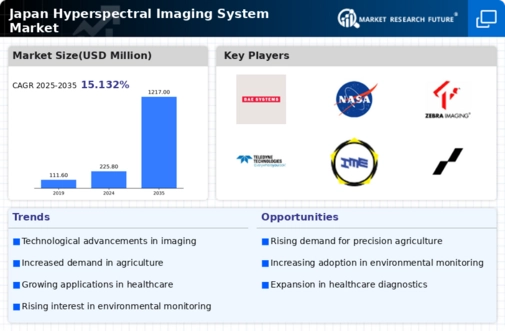Expansion of Industrial Applications
The hyperspectral imaging-system market is witnessing an expansion of industrial applications in Japan. Industries such as food processing, pharmaceuticals, and materials science are increasingly recognizing the value of hyperspectral imaging for quality control and process optimization. For instance, in the food industry, hyperspectral imaging can be utilized for detecting contaminants and assessing product quality. This trend is likely to drive market growth, as companies seek to enhance operational efficiency and ensure compliance with stringent quality standards. The industrial sector's growing reliance on advanced imaging technologies suggests a promising future for the hyperspectral imaging-system market, with potential revenue growth projected to reach several million dollars in the coming years.
Rising Demand for Precision Agriculture
The hyperspectral imaging-system market in Japan is experiencing a notable surge due to the increasing demand for precision agriculture. Farmers are increasingly adopting advanced technologies to enhance crop yield and quality. Hyperspectral imaging systems provide detailed spectral information that aids in monitoring plant health, soil conditions, and nutrient levels. This technology allows for targeted interventions, reducing resource wastage and improving overall efficiency. According to recent estimates, the market for precision agriculture in Japan is projected to grow at a CAGR of approximately 15% over the next five years. This growth is likely to drive the adoption of hyperspectral imaging systems, as they play a crucial role in optimizing agricultural practices and ensuring sustainable food production.
Growing Focus on Environmental Monitoring
The hyperspectral imaging-system market is benefiting from a growing focus on environmental monitoring in Japan. With increasing concerns about climate change and pollution, there is a heightened need for accurate data collection and analysis. Hyperspectral imaging systems offer the ability to detect and quantify environmental changes, such as land use alterations and water quality degradation. This capability is particularly relevant for governmental and non-governmental organizations engaged in environmental protection efforts. The market for environmental monitoring technologies in Japan is expected to expand, with hyperspectral imaging systems playing a pivotal role in providing the necessary data for effective policy-making and resource management.
Advancements in Remote Sensing Technologies
The hyperspectral imaging-system market is significantly influenced by advancements in remote sensing technologies. In Japan, the integration of satellite and aerial imaging with hyperspectral data is enhancing the capabilities of environmental monitoring and resource management. These systems enable the collection of high-resolution data across various wavelengths, facilitating applications in forestry, water quality assessment, and urban planning. The Japanese government has invested heavily in satellite technology, which is expected to bolster the hyperspectral imaging market. As remote sensing technologies continue to evolve, the demand for hyperspectral imaging systems is anticipated to increase, providing critical insights for decision-makers in various sectors.
Increased Investment in Research and Development
Investment in research and development (R&D) is a key driver for the hyperspectral imaging-system market in Japan. The country is known for its strong emphasis on innovation and technology advancement. Various academic institutions and private companies are collaborating to develop new applications and improve existing hyperspectral imaging technologies. This focus on R&D is likely to lead to the introduction of more sophisticated systems that can cater to diverse industries, including healthcare, defense, and manufacturing. As R&D efforts intensify, the market is expected to witness a surge in innovative solutions, further propelling the adoption of hyperspectral imaging systems across different sectors.




















Leave a Comment